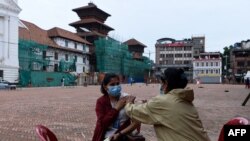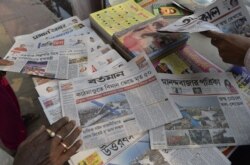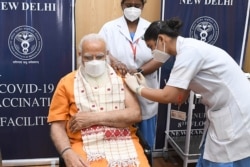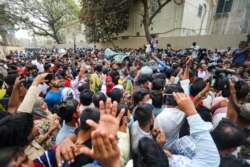In Nepal, despite threats of COVID-19 infection and dwindling salaries, reporters are working tirelessly on the ground to cover the pandemic.
When journalist Kailash Joshi was infected with COVID-19, he kept doing his job, tracking stories for two media outlets while isolating himself at home. He is just one of the dedicated journalists in Nepal working around the clock to cover the pandemic, even in the face of risks to their own health and limited resources.
Joshi’s story, originally published by the Nepal newspaper Nagarik on World Press Freedom Day, was able to reach a larger audience with the help of a new project with the International Press Institute (IPI), a Vienna-based global network dedicated to the protection of press freedom.
Launched in December 2020, the project, titled “Covering and investigating attacks against journalists in South Asia: a Cross-Border cooperation,” collaborates with IPI members at five news outlets across South Asia, including The Daily Star in Bangladesh, The Week in India, Dawn in Pakistan, as well as Nagarik and Republica in Nepal.
“The project raises awareness about the dangers that journalists face to carry out their job and the failure of state institutions to create a climate in which the press can operate independently and without fear of retaliation,” Barbara Trionfi, director of IPI, told VOA.
Each newspaper documents threats to journalists and press freedom violations through stories that are then shared and re-published in the partner outlets.
The project, which receives partial funding from UNESCO’s Global Media Fund, works as both a means of documentation and advocacy.
“IPI leads the advocacy efforts, which gain in strength thanks to the visibility that the news outlets can offer," Trionfi explained. "At the same time, IPI’s advocacy is successful because it is based on accurate facts collected by the leading [investigative] journalists in each country.”
For reporters, IPI’s project provides a wider readership and an opportunity to connect with journalists facing similar obstacles in other countries.
“The IPI project has connected journalists and increased their awareness of assaults on press freedom in neighboring countries,” V.S. Jayaschandran, editor in charge of Indian news magazine, The Week, told VOA in an email interview.
“My reporters felt professional satisfaction on their being published in newspapers abroad,” Jayaschandran said.
Connecting with newspapers abroad is an important part of IPI’s project.
“The cross-border aspect of the project is particularly important and it highlights similarities and shared values between independent journalists and editors in the four countries,” Trionfi told VOA.
Press freedom threats in South Asia
“South Asia remains one of the most dangerous places to practice journalism, with frequent attacks against the press and very high levels of impunity in crimes against the media,” Trionfi said.
Ravi Prasad, advocacy director at IPI, said in an email interview with VOA that growing authoritarianism and intolerance to criticism from the media are two major concerns for press freedom in South Asia.
Reporters Without Borders’ (RSF) 2021 World Press Freedom Index, which ranks countries on a scale of 1 to 180, with 1 being the most free, found independent journalism to be under attack in Bangladesh, Nepal, and Sri Lanka. And in Pakistan, ranked at 145, the media is largely under the control of the Pakistani military.
In India, ranked at 142 on RSF’s scale, after 2019 elections brought more power to Prime Minister Modi's party, the overall state of press freedom in the country has worsened. Journalists are often the subject of social media campaigns that threaten the press with violence. Legal retaliation is also used as a means of censorship.
“The government of President Modi has become increasingly intolerant [of] critical opinions and has passed various laws to criminalize independent, critical journalism,” Trionfi told VOA.
Jayaschandran says laws such as the Armed Forces Special Powers Act (AFSPA) also hurt press freedom in India.
AFSPA gives more power to armed forces in “disturbed areas,” and, among other things, allows the army to arrest and search without a warrant and open fire on citizens in certain cases. The law has been criticized by the Human Rights Watch as “a tool of state abuse.”
India’s Unlawful Activities (Prevention) Act also has been used to block free speech, Jayaschandran said.
Similar laws have been used across South Asia to target the press.
“Countries in South Asia emulate India in terms of laws and regulations, and often go beyond these laws to enact legislations that are draconian,” Prasad told VOA.
In Bangladesh, a 2018 Digital Security Act, which threatens a maximum sentence of life imprisonment, targets journalists who criticize the government’s handling of the pandemic, Prasad explained.
While the pandemic has brought more challenges to journalists, including financial stress for newsrooms and threats of government censorship, the crisis also has highlighted the importance of a free press.
“As governments are trying to control the narrative about the health crisis through curbing freedom of expression and freedom of opinion, and by filing cases against journalists, there is certainly a heightened conversation about press freedom and safety of journalists in South Asia,” Prasad told VOA.
Prasad said the stories published through IPI’s project have strengthened journalists’ voices, and “in the long run are bound to have an impact on the policies and practices in these countries.”
Jayaschandran echoed a similar hope that stories published through IPI’s project may “persuade governments to be more responsive and empathetic.”











